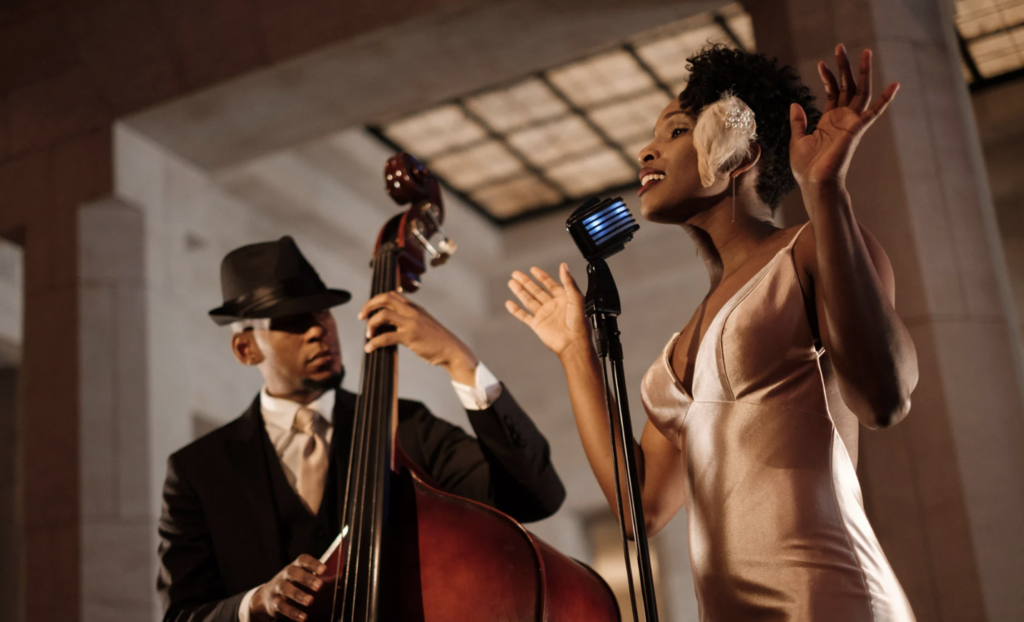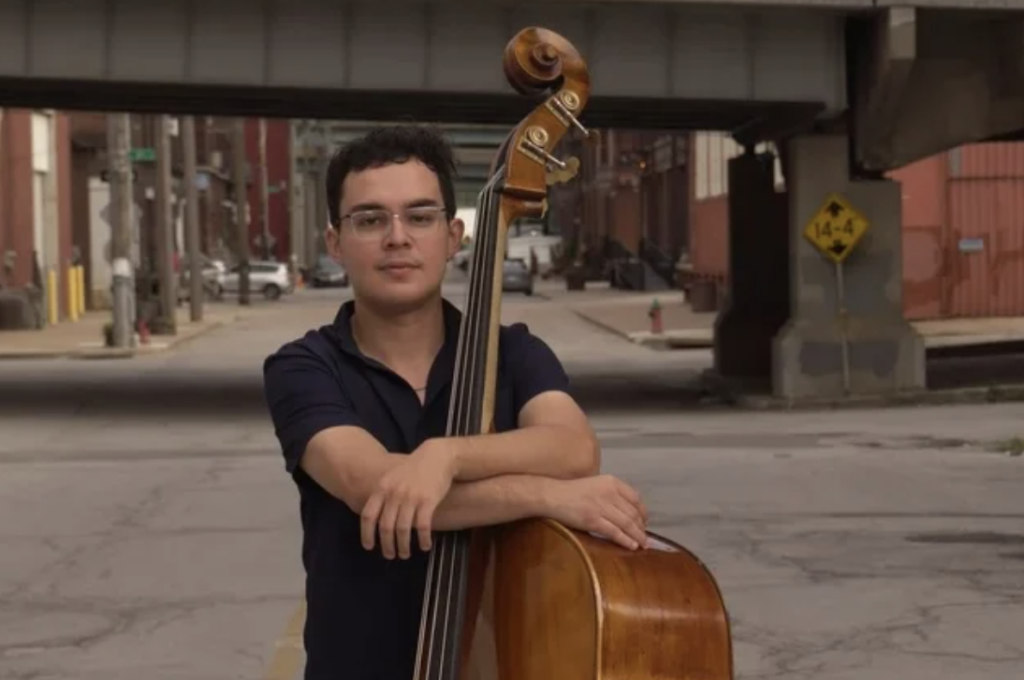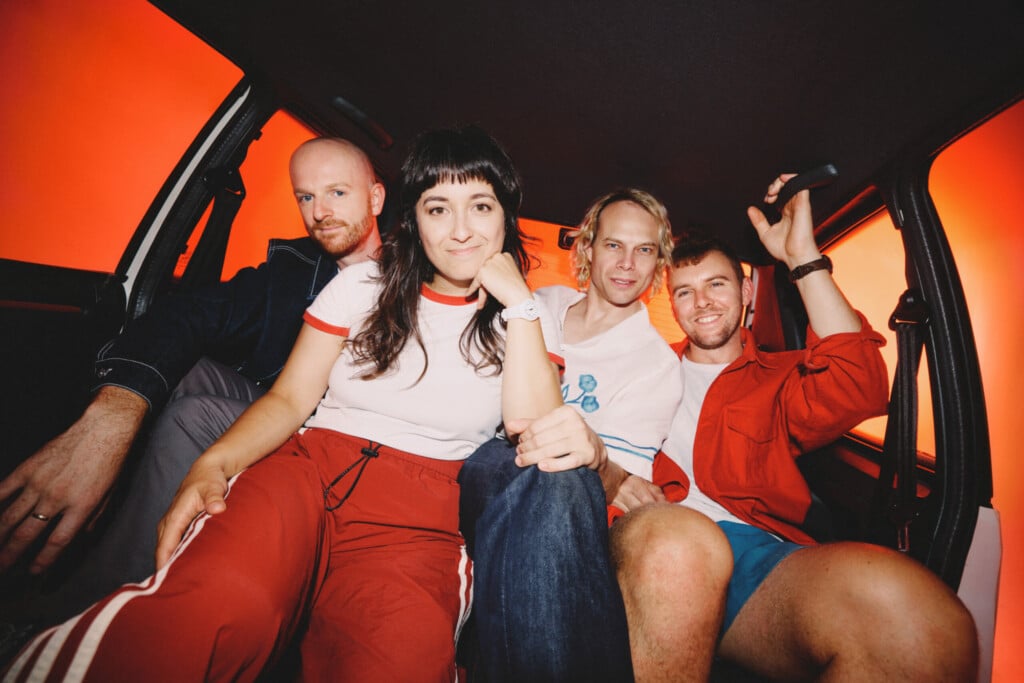KC’s Sebastian Arias is a ‘fearless’ bassist not just proving ground, but paving ground
It is Free Jazz Thursday at The Ship in Kansas City’s West Bottoms with the Adam Larson Band. And the party tone is set.
Is it jazz? Is it Motown? It is certainly soulful. Bassist Sebastian Arias is glowing, laying the foundation, showing in his solo, just a boy in a band enjoying the life he has forged. He is home yet, someday, this will be stamped as a maturing ground. An evolution, yes, but a time, a place, where a life was launched.
“I give it all every time I play,” says the 27-year-old Arias after the show.
Indeed, as the tempo takes a leap, Arias’s electric notes come rapid fire, pairing with the drums, then leading to new grooves. Foundation becomes feature. The bass life turns life in the fast lane.
To Arias, life in Kansas City has been a whirlwind. After an invitation from long-time mentor and Professor of Jazz Studies Carl Allen at the University of Missouri at Kansas City, Arias arrived in 2023 to gain his Master’s degree at age 25, knowing no one but Allen. And, admittedly, not knowing much about the Kansas City jazz scene. But the fruitful network of a revered school and a simple fact–“everybody [with a band] needs a bass player”–has made Arias “the most working bass player in town right now,” according to pianist, Andrew Ouellette.
‘In with the good; out with the bad.’
“It has been cool to see Sebastian’s progression,” begins renowned saxophonist Adam Larson. Larson himself was a catalyst, calling on Arias to sub in his trio with him and drummer John Kizilarmut–an almost telepathic partnership–shortly after Arias’s arrival. “For anybody to step into that [established] trio, especially as a bassist, is intimidating. Never once has [Sebastian] not risen to the occasion. He’s an amazing bassist.”
Beyond mentors like Allen, an inspiration and an idol in bassists Victor Wooten and Christian McBride, and playing with established artists like Larson, Arias’s rise lies with his parents back in Costa Rica, and a happy accident.
“The town I grew up in didn’t have much of a music scene,” says Arias. But it had a strong conservatory school that his parents encouraged him to join at age six. Still, Arias wasn’t biting.
When Arias was eight, he began fiddling with a friend’s guitar. Noticing, his parents bought him a guitar for his ninth birthday. And Arias began to sink in his teeth, taking lessons from a couple of people from the conservatory. Though happy, life inspiration slumbered until one instructor nodded at a corner: “Let me show you this over here.” The bass player, moonlighting as a guitar instructor, turned his bass on and played. In with the good…
“I was like, ‘Oh, wait, that’s pretty cool,’ and he introduced me to his teacher,” Arias says with a glimmer. “Things went from there. By the time I was 12, I couldn’t think of doing anything else, to be honest. It’s so much fun, and it’s one of the ultimate ways we can express ourselves.”
From jetting to Salt Lake City at age 18 for his undergrad, to his Master’s in Kansas City, to a staple on the scene, it has been Arias’ sure talent, but also his workmanlike attitude and humble perspective that have him thriving.
“He can filter whatever you give him in a way that makes him a better musician, which is rare. A lot of people who hear criticism, or perceive criticism, take it inwardly and make the music sound worse,” says Larson.” He takes it; he filters it. You have seen Happy Gilmore, right? Kevin Nealon’s character says, ‘In with the good; out with the bad.’ That is Sebastian.”
“Guitar is for the head, drums are for the chest, but bass gets you in the groin.” –bass player, singer, actress, songwriter Suzi Quatro
Two weeks previously, Arias was playing upright bass at The Majestic with the Matt Villinger Trio. He is in his inner self, not just playing the notes but enacting that deeper musical language that speaks to us all. Almost vocalizing the notes, his countenance reflects the space the notes will invade before his fingers even catch up.
A smile breaks out as bass and Villinger on piano find complementary inflections, subtle, profound soul food. Going at Villinger and drummer Zach Morrow, Arias dares them to keep up. His head bops with each accent as his playful run pushes the trio forward, his fingertips blur across the range of the fingerboard in marvelous consistency.
“With [Sebastian’s] mentality and skillset, we are lucky to
have him here when we do.”
–renowned saxophonist Adam Larson
“And he has a super clear bass tone that is really unique,” wonders Ouellette before confirming the suggestion that Arias is a melodic bass player. “Absolutely, he sings his lines. He’s not just phoning in the bass part when he is not soloing. He is almost copying what a piano player or guitar player [would play], but on bass. Some guys are more passive. He takes charge of what is going on up there.
“You never have to worry; he’s not going to be the one messing up. He is as good as any bass player you are going to find anywhere.”
Larson goes further, explaining, “I appreciate [the energy] he brings to the music. He’s fearless. He is not ever shying away from the moment.”
Even when things go “sideways” and the players have to listen and arrange instinctively, Arias “always seems to find the right notes,” continues Larson.
For Arias, staying “as present as possible” is the key, despite the overwhelming emotions playing music in a band can bring.
“I have a lot of excitement when I play,” he said. “If the emotions take over, you lose control. Learning how to channel those emotions and use that feel for what you are playing is key [to performing well].”
Make no mistake, however, Arias loves the feeling of being in a band. Even competing in a band.
“’He’s playing at that level? I better step it up, or even take it a step further,’” states Arias, mimicking those moments. “‘I’m going to give you this; let’s see what you got.’ Ultimately, the goal is to elevate each other. Put in the music first, then all that after. It makes the music really fun.”
“Sebastian’s phone doesn’t stop ringing, for all the right reasons,” Larson acknowledges. “I would encourage people to seek him out–not only in KC, but on a national level–because he will not be here forever. Somebody with his mentality and his skillset, we are lucky to have him here when we do.”
In the quieter moments… dreams flourish.
In the quieter moments at The Ship, Arias paves ground feet can glide over, compelling couples to find space, any space to dance. Yet, Arias propels their steps in a new direction, raising them to new inspiration, much like he sees his present and dreams his hopeful future. Arias praised Kansas City’s organizations and players past and present for setting a high standard for young musicians.
“Another thing I am enjoying is the community building around people my age,” he says. “There are a lot of talented people in their twenties who are doing great things. That is inspiring.”
Thus, his goals are clear: “Two things: do my part to elevate that community as a bass player by being somebody people can look up to. Kansas City has history, a lot of great musicians that have come out of here and are doing great things out in the world. I’d like to follow in their steps.”
Famous jazz bassist Ray Brown, on his second day in New York found himself in the same room as Dizzy Gillespie, Charlie Parker, Bud Powell, and Max Roach. “Scared shitless, but a nice place to be,” said Brown. Arias has the same “good ol’ dream” as he puts it.
“I love Kansas City, but I would love at some point to spend some time in New York or Los Angeles, those scenes still have a huge conglomeration, a level of music that only they have. I would love to be exposed to that environment and that kind of energy. The other thing is to try to play with as many great musicians as I can. That is one of the ultimate ways to get better, to learn.”
“Wherever the music takes me. It’s always been a goal of mine [to travel]…. You never know where music is going to take you. Let it do its thing.”
Like a reader with a prized book, a writer with prized pages, a singer with a found satisfaction, Arias lives the bass. He lives the music, that sweet siren that eventually seduces all.
“Wherever you are at, make it a point to watch out for the local artists,” says Arias of those living their craft in Kansas City. “Go find live music any chance that you get. Jazz, especially, is such a social [platform]. Don’t be afraid to experience new things, things that might be unfamiliar.”
And just maybe, the listener’s enjoyment may turn to envy or inspiration.
In fact, Arias is searching for his best gig so far, working so his next one “will be my new favorite.”
“[Tonight], there was so much energy. None of the musicians were messing around,” he says. “There was no time to be distracted for one second. We went a lot of places.”
Paving ground with life in the fast lane: with the constant drive of a famed car chase, the hum of the tires over terrain, the firing of pistons, the assuredness of adventure, the inevitability of daring, and the incense of conflagration, Arias drives.







